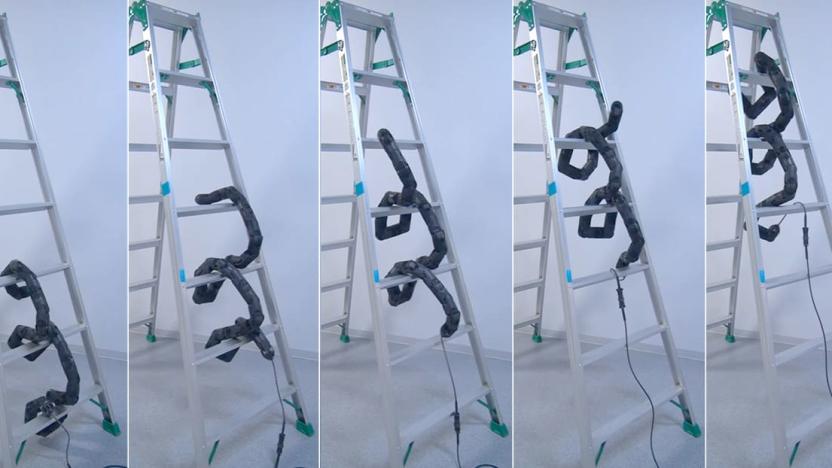Disasters
Latest

Robot makes 'Snakes and Ladders' horrifyingly literal
Robots can't yet think for themselves, but if they ever do, you'll have nowhere to hide. Researchers from Kyoto University and the University of Electro-Communications unveiled a snake-like robot that can climb up a ladder in a terrifying version of the children's board game. It's not the first robot snake we've ever seen, but this latest model, unveiled at the 2018 IEEE/RSJ International Conference on Intelligent Robots and Systems, looks like the most agile one yet.

Lyft expands its free ride program to veterans and job-seekers
Last year starting with Hurricane Harvey in Houston, Lyft launched its "Relief Rides" program for folks caught in hurricanes and other emergencies. Now, the ride-sharing company has announced that it will start offering its services in non-emergency situations, too. It has committed $1.5 million to upgrade the program, giving returning veterans and low-income job-seekers access to rides for job interviews, medical visits and more.

Japan considers using social networks in disaster situations
Emergency services are embracing technology as new ways to investigate, send alerts and receive reports of crises. And now, the Japanese are looking at social networks to support communication in disaster scenarios, especially when traditional services fail. The local Fire and Disaster Management Agency put together a panel discussion on just that topic, with representatives attending from the likes of Twitter, Yahoo, Mixi and NHN Japan, as well as various government and emergency bodies. The talk was motivated, in part, by the March tsunami, when the internet was the sole means of information for some, and with initiatives like Google's Person Finder playing a role in the aftermath. Any formal implementation of the ideas discussed is probably a long way off, and this is the first of three planned meets to hash it out. In the meantime, however, Twitter's Japanese blog posted some suggestions on how their network could be used in emergencies -- we just hope they won't be needed anytime soon.

Sony intros 200-pound battery to power businesses, government agencies during a blackout
In the five months since a tsunami and 9.0 magnitude earthquake hit Japan, we've seen various technology companies struggle to get their manufacturing operations back in order, but Sony appears to be the first to introduce a product seemingly inspired by the disaster itself. The outfit's Japanese division just announced the ESSP-2000, a 90kg (198-pound)battery whose 2.4kWh of power should keep businesses and government agencies afloat for at least a few hours in the event of a blackout or natural disaster. All told, the battery can support a maximum load of 1000VA, and can recharge to 95 percent in about two hours -- not bad, considering the capacity of this thing. Sony also went with olivine-type lithium-ion iron phosphate batteries, which it says will last ten years. With a price of ¥2 million ($25,700), this battery's clearly not meant to be a savior for home users, though for businesses it could be a small price to pay for an uninterrupted power supply.

Japan to open virtual disaster prevention museum
No, not actually for the prevention of virtual disasters. The Daily Yomiuri tells us that the Japanese government is planning a virtual museum in Second Life focusing on disaster prevention in order to promote awareness of disaster management and techniques and technologies to mitigate the impact of a wide range of disasters. Initial exhibits will demonstrate how non-earthquake hardened buildings respond to seismic events, and the impact of tornados on urban settings. Unfortunately, we think that it's unlikely to include such disasters as Godzilla, Orga, Mothra or Rodan. Nonetheless, the potential educational benefits of such an installation are hard to deny -- the impact and effects of natural disasters can be almost inconceivable to those who have not directly experienced such events or their aftereffects themselves.

Photoshop disasters for your weekend amusement
We've all seen our fair share of Photoshop, whether we know it or not. The PhotoshopDisasters blog, however, is compiling the most bizarre (and funny) examples of extra limbs, flipped text, and heads that don't belong to their associated bodies. Not that I'd know anything about that. Apparently, Australian iPhones will run Windows XP. Who knew? [Via It's Nice That]

DHS looking to satellites, mesh networks for emergency communications
Seeking to avoid the communication breakdowns that occurred as a result of the September 11th terrorist attacks and the Hurricane Katrina disaster, the Department of Homeland Security is developing an emergency network that would let officials email one another even in the absence of a cellular infrastructure. The DHS' Advanced Research Projects Agency, which is analogous to the Pentagon's DARPA, is looking at a number of options to keep the data flowing following an emergency, including widespread deployment of mobile mesh networking technology or re-purposing some of the government's legacy satellites to handle terrestrial communications. This latter option is particularly attractive because some sats could offer transfer rates in excess of 100Mbps, and in fact a trial program is scheduled for this summer that will employ modified BlackBerries and Treos to send secure, satellite-based email between Homeland Security officials and the Royal Canadian Mounted Police.[Via Smart Mobs]


